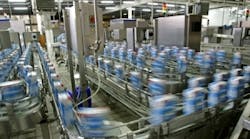The proliferation of new information technologies has brought numerous benefits to the food-processing industry, including improvements in overall productivity and efficiency. At the same time, the industry continues to experience major lapses in safety and quality, which have been magnified in recent months by several highly publicized product recalls.
A problem at many plants stems from an environment of fragmented processes and disconnected systems, each with their own specific data. Coupled with the paper-based approach used by many organizations, resources are overloaded trying to track safety and quality processes while inconsistencies and waste still abound.
Unconnected data sources and manually tracked quality processes lead to a lack of real-time information. The result is latency in addressing quality issues and an inability to identify the root cause of a quality deviation. Additionally, critical production decisions are frequently based on assumptions instead of accurate and reliable information.
These operational deficiencies may be key contributors to recent recalls. They also point to a need for improvement in managing the entire supply chain and implementing tighter control, monitoring, and real-time information delivery on production processes. To achieve optimum performance, manufacturers need timely information about the production process in order to effectively analyze and detect undesirable trends, and take immediate corrective action when needed. Once these best practices are defined, manufacturers can enforce them, and where possible, apply the capability to build quality directly into the solution so the product is manufactured correctly the first time.
This is where an integrated quality-management solution can pay substantial dividends. Despite the natural hesitation of the industry to tinker with a proven, albeit cumbersome, paper-based system of quality-management, the underlying benefits of this integrated solution have become too promising to ignore.
Step One: Turn Your Data into Intelligence
A central component in an effective quality-management strategy is the ability to gather and correlate information from multiple sources so decision-makers across the enterprise can see diverse views and maintain key relationships. Reports, key performance indicators (KPIs) and operational metrics can then be assembled quickly into dashboards to help management measure performance across the facility.
By connecting disparate data sources, quality control staff can access intelligent information that provides exception alerts through live information connections while helping managers determine precisely where, when and why mistakes are occurring. The real-time intelligence can automatically drive user attention toward exception conditions, missed targets and plan deviations.
Once these disparate data sources are connected, operators can apply manufacturing intelligence dashboards as a key driver of quality improvement initiatives. These dashboards offer a simple graphical way to display KPIs throughout the enterprise. By putting data into context, dashboards allow operators to make immediate process corrections in real time, instead of after the fact. This can result in significant improvements in output, yield and first-pass quality.
The ability of dashboards to display metrics in rich graphic representations contributes to quicker actions by helping operators better understand how to respond to the intelligence. For example, a quick glance at a trend-oriented graphic can provide powerful insight into performance history and status (compared to raw numbers). It also can help users more effectively make comparisons of multiple data sources using the dimension of time or a production run.
Step Two: Define and Enforce Your Quality Process
Step two in improving food quality is dependent on ensuring the product you are manufacturing is repeatedly made with the same quality. By using the correlated information gathered during step one, you can make improvements in the overall production process and establish best practices.
Once defined, it is necessary to enforce this best practice to ensure the product is created in the same way every time. This enforcement can then be achieved with a procedural control application that ensures the use of best practices regarding the raw materials, processing equipment and operational procedures (manual and automatic) that are used to create the product.
Step Three: Apply Predictive Quality
The third step in providing improvements in food quality is through the application of predictive quality. Predictive control technologies rely on advanced modeling techniques based on timely in-process measurements that allow users to simulate processes, run what-if scenarios and determine how process input changes impact output. Steady-state optimizations also can be performed by setting output variable targets and letting the models determine optimum input targets.
Bringing it All Together
Food manufacturers are increasingly realizing the inherent value and tangible returns of integrated quality-management systems. The derived data provides information that can be used to empower employees with improved vision, correlate and trend data, and achieve marked improvements in quality through prediction and control -- all of which help reduce risk and improve profitability.
For more information about quality-management solutions, please visit http://www.rockwellautomation.com/rockwellsoftware/cpg/
This is the pre-peer reviewed version of the following article: "Leveraging the Power of Information," which has been published in final form at http://www.foodquality.com/mag/04012010_05012010/fq_04012010_MD2.html.
Sponsor Links



